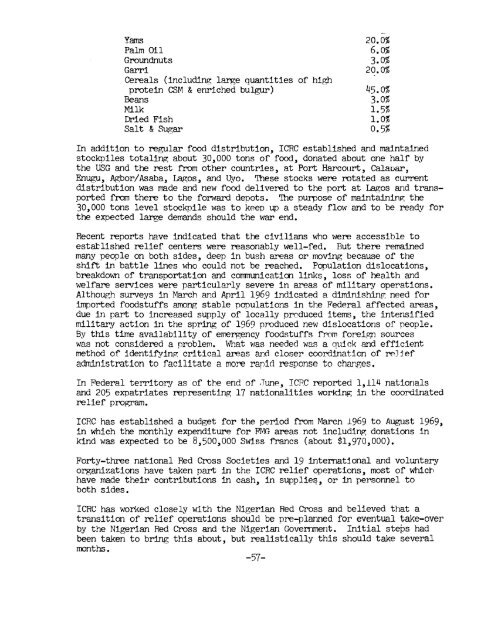3. - usaid
3. - usaid
3. - usaid
You also want an ePaper? Increase the reach of your titles
YUMPU automatically turns print PDFs into web optimized ePapers that Google loves.
Yams<br />
Palm O il<br />
Groundnut s<br />
Garri<br />
Cereals (includinp: large quantities of hip&<br />
protein CSM & enriched bulgur)<br />
Beans<br />
Milk<br />
Dried Fish<br />
Salt & Sugar<br />
In addition to regular food distribution, ICRC established and maintained<br />
stockpiles totaling about 30,000 tons of food, donated about one half by<br />
the USG and the rest from other countries, at Port Harco~lrt, Calauar,<br />
Enugu, Agbor/Asaba, Lagos, and Uyo. These stocks were rotated as current<br />
distribution was made and new food delivered to the port at Lagos and transported<br />
from there to the forward depots. The purpose of maintaining the<br />
30,000 tons level stockpile was to keep up a steady flow and to be ready for<br />
the expected large demands should the war end.<br />
Recent reports have indicated that the civilians who were accessible to<br />
estak lished relief centers were reasonably well-fed. Rut there remained<br />
many people on both sides, deep in bush areas or moving because of the<br />
shift in battle lines who could not be reached. Population dislocations,<br />
breakdown of transportation and comnunicatim links, loss of health and<br />
welfare services were particularly severe in arcas of military operations.<br />
Although surveys in March and April 1969 indicated a diminishing need for<br />
imported foodstuffs among stable populations in the Federal affected areas,<br />
due in part to increased supply of locally pr~duced items, the intensified<br />
military action in the spring of 1965, produced new dislocations of people.<br />
By this time availability of emergency foodstuffs fmm foreipp sources<br />
was not considered a nroblem. What bras needed was a qulck and effl-cient<br />
method of identifying critical areas rn-d closer coordinatAon of rc! i ef<br />
administration to facilitate a molle papid response to ch,uges.<br />
In Federal territory as of the end of *Tune, ICFC reported 1,114 nationals<br />
and 205 expatriates representing 17 nationalities working in the coordinated<br />
relief program.<br />
ICRC has established a budget for the period from March 1969 to August 1969,<br />
in which the monthly expenditure for F'MG areas not includiqq donations in<br />
kind was expected to be 8,500,000 Swiss francs (about $1,970,000).<br />
Forty-three national Red Cross Societies and 19 internatlonal and voluntary<br />
organizations have taken part in the ICRC relief operations, most of which<br />
have made their contributions in cash, in supplies, or in personnel to<br />
both sides.<br />
ICRC has worked closely with the Nigerian Red Cross and believed that a<br />
transition of relief operations should be pre-planned for eventual take-over<br />
by the Nigerian Red Cross and the Nigerian Government. Initial steps had<br />
been taken to bring this about, but realistically this should take several<br />
months .<br />
-57-
















